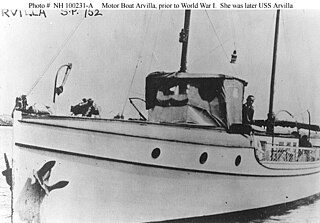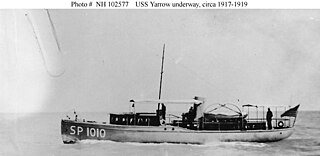 USS Nirvana, later USS SP-706, sometime during World War I. | |
| History | |
|---|---|
| Name: |
|
| Namesake: | Nirvana was a previous name retained; SP-706 was her section patrol boat number |
| Builder: | S. O. Hauser, Staten Island, New York |
| Completed: | 1915 |
| Acquired: | 21 May 1917 |
| Commissioned: | 10 August 1917 |
| Decommissioned: | 31 December 1917 |
| Recommissioned: | 18 April 1918 |
| Decommissioned: | 20 January 1919 |
| Renamed: | USS SP-706 April 1918 |
| Fate: | Returned to owner 20 January 1919 |
| Notes: | Operated as civilian motorboat Tarpon II and Nirvana 1915-1917 and Nirvana from 1919 |
| General characteristics | |
| Type: | Patrol vessel |
| Length: | 40 ft (12 m) |
| Beam: | 10 ft (3.0 m) |
| Draft: | 2 ft 6 in (0.76 m) |
| Speed: | 18 miles per hour [1] |
| Armament: | 1 × machine gun |
USS Nirvana (SP-706), later USS SP-706, was a United States Navy patrol vessel in commission in 1917 and from 1918 to 1919.

The United States Navy (USN) is the naval warfare service branch of the United States Armed Forces and one of the seven uniformed services of the United States. It is the largest and most capable navy in the world and it has been estimated that in terms of tonnage of its active battle fleet alone, it is larger than the next 13 navies combined, which includes 11 U.S. allies or partner nations. with the highest combined battle fleet tonnage and the world's largest aircraft carrier fleet, with eleven in service, and two new carriers under construction. With 319,421 personnel on active duty and 99,616 in the Ready Reserve, the Navy is the third largest of the service branches. It has 282 deployable combat vessels and more than 3,700 operational aircraft as of March 2018, making it the second-largest air force in the world, after the United States Air Force.

Nirvana was built as the civilian motorboat Tarpon II in 1915 by S.O. Hauser at Staten Island, New York. She later was renamed Nirvana.
The U.S. Navy acquired Nirvana from her owner, M. S. Martin, on 21 May 1917 for World War I service as a patrol vessel on the section patrol. She was commissioned as USS Nirvana (SP-706) on 10 August 1917.

World War I, also known as the First World War or the Great War, was a global war originating in Europe that lasted from 28 July 1914 to 11 November 1918. Contemporaneously described as "the war to end all wars", it led to the mobilisation of more than 70 million military personnel, including 60 million Europeans, making it one of the largest wars in history. It is also one of the deadliest conflicts in history, with an estimated nine million combatants and seven million civilian deaths as a direct result of the war, while resulting genocides and the 1918 influenza pandemic caused another 50 to 100 million deaths worldwide.

A Section Patrol craft was a civilian vessel registered by the United States Navy for potential wartime service before, during, and shortly after World War I.
Ship commissioning is the act or ceremony of placing a ship in active service, and may be regarded as a particular application of the general concepts and practices of project commissioning. The term is most commonly applied to the placing of a warship in active duty with its country's military forces. The ceremonies involved are often rooted in centuries old naval tradition.
Assigned to the 3rd Naval District, Nirvana reported to Fort Lafayette in New York Harbor on 18 August 1917 and patrolled between City Island in the Bronx and Fort Lafayette until decommissioned on 31 December 1917.

Fort Lafayette was an island coastal fortification in the Narrows of New York Harbor, built offshore from Fort Hamilton at the southern tip of what is now Bay Ridge in the New York City borough of Brooklyn. The fort was built on a natural island known as Hendrick's Reef. Construction on the fort began during the War of 1812 and was completed in 1822. The fort, originally named Fort Diamond after its shape, was renamed in 1823 to celebrate the Marquis de La Fayette, a hero of the American Revolution who would soon commence a grand tour of the United States. The fort was demolished in 1960 to make room for the Verrazano-Narrows Bridge; the Brooklyn-side bridge tower now occupies the fort's former foundation site.
Recommissioning on 18 April 1918, Nirvana was renamed USS SP-706. She steamed to Erie, Pennsylvania, arriving there on 10 June 1918, and transferred to the 10th Naval District. She patrolled the Great Lakes through the end of World War I.

The Great Lakes, also called the Laurentian Great Lakes and the Great Lakes of North America, are a series of interconnected freshwater lakes primarily in the upper mid-east region of North America, on the Canada–United States border, which connect to the Atlantic Ocean through the Saint Lawrence River. They consist of Lakes Superior, Michigan, Huron, Erie, and Ontario, although hydrologically, there are four lakes, Superior, Erie, Ontario, and Michigan-Huron. The connected lakes form the Great Lakes Waterway.
Returning to Marine Basin in New York City on 8 December 1918, SP-706 was decommissioned on 20 January 1919 and returned to her owner the same day.
USS Nirvana should not be confused with another patrol vessel in commission from 1917 to 1918 under the name USS Nirvana II (SP-204).















